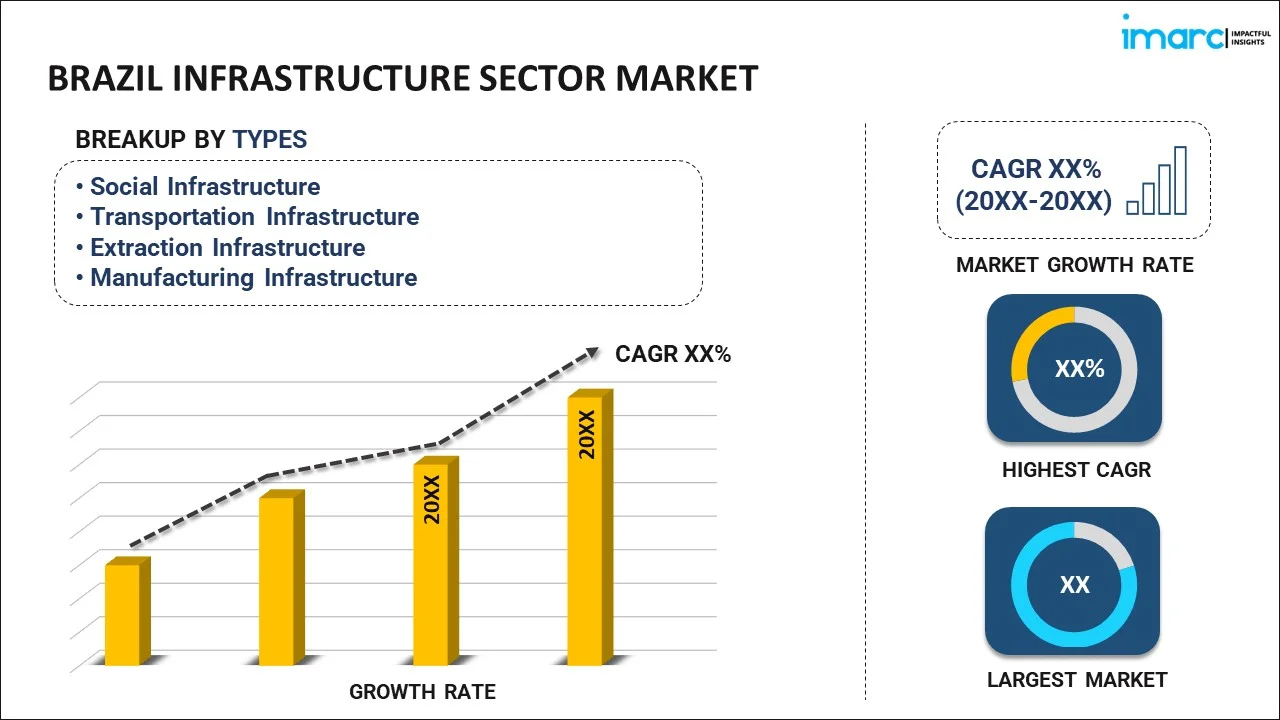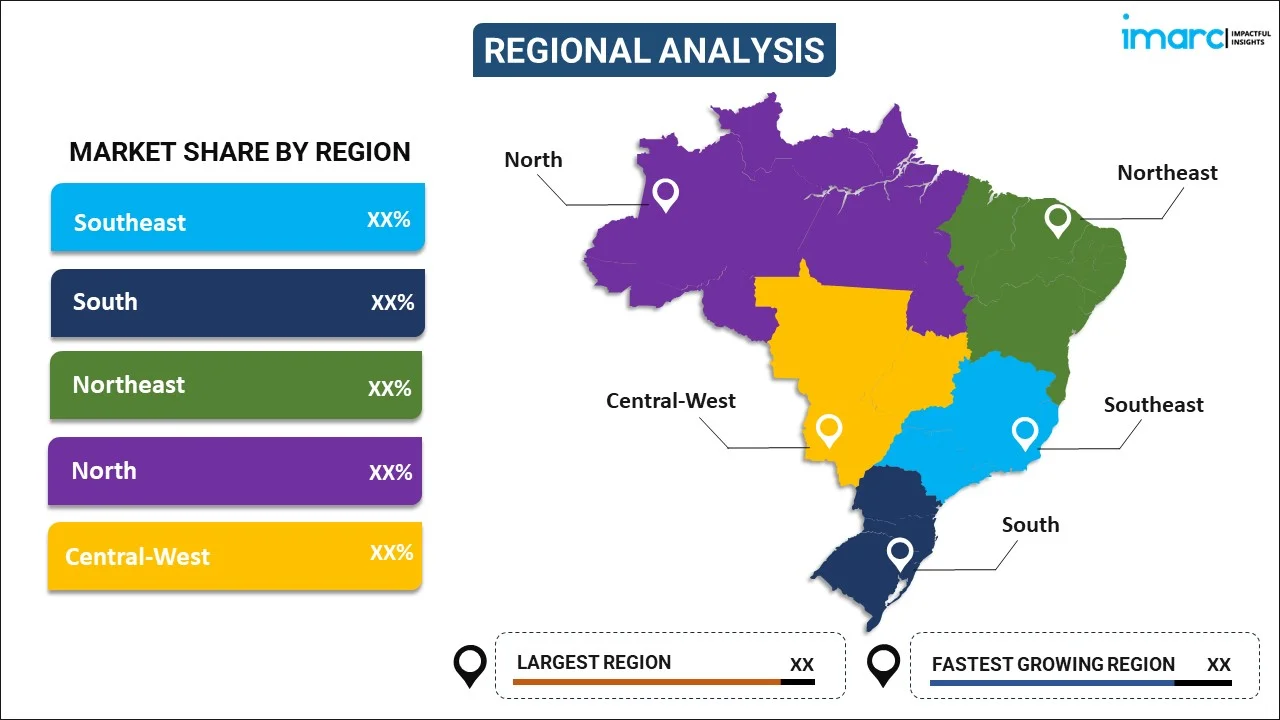
Brazil Infrastructure Sector Market Report by Type (Social Infrastructure, Transportation Infrastructure, Extraction Infrastructure, Manufacturing Infrastructure), and Region 2024-2032
Market Overview:
Brazil infrastructure sector market size is projected to exhibit a growth rate (CAGR) of 4.59% during 2024-2032. Rapid urbanization, increasing investments in wind, solar, and biomass energy sources, and the rising focus of the regulatory bodies on providing clean drinking water, sanitation, and improved transportation represent some of the key factors driving the market.
|
Report Attribute
|
Key Statistics
|
|---|---|
|
Base Year
|
2023 |
|
Forecast Years
|
2024-2032
|
|
Historical Years
|
2018-2023
|
| Market Growth Rate (2024-2032) | 4.59% |
The infrastructure sector is a broad economic category that encompasses the fundamental physical and organizational systems, facilities, and structures required for the efficient functioning of a society, region, or industry. It includes roads, highways, bridges, railways, airports, seaports, and public transit systems that facilitate the movement of people and goods. It also encompasses electricity grids, water supply networks, wastewater treatment facilities, and gas pipelines that support daily life and economic activities. Besides this, it involves high-speed internet access, data networks, and communication systems, which support connectivity, information exchange, and digital services. It can mitigate the impact of disasters, enabling swift recovery and reducing societal vulnerabilities. It enhances productivity, reduces transportation costs, and attracts investment. In addition, it ensures access to medical services and contributes to public health.
Brazil Infrastructure Sector Market Trends:
Rapid urbanization and the development of smart cities, improved housing, and efficient public services represent one of the key factors positively influencing the market. Additionally, improvements in high-speed internet connectivity and the fifth generation (5G) network access to digital services, e-commerce, and remote work are contributing to the market growth. Along with this, the rising adoption of innovative construction technologies and materials is improving the efficiency and sustainability of infrastructure projects. Apart from this, increasing investments in wind, solar, and biomass energy sources are attracting domestic and foreign investments. Furthermore, the ongoing construction of major highways is facilitating the movement of agricultural goods from the interior of Brazil to export hubs. Additionally, the development of urban transport systems, including metro systems and bus rapid transit (BRT) systems, is improving mobility in major cities like São Paulo and Rio de Janeiro. Moreover, governing agencies in the country are actively investing in infrastructure development, which includes upgrading transportation networks, energy systems, and utilities. In addition, they are undertaking numerous initiatives, such as the development of the Investment Partnership Program (PPI), which is attracting private investment and enabling the execution of large-scale projects. These investments are improving connectivity, reducing logistics costs, and enhancing the overall competitiveness of Brazil. Besides this, rising collaborations between governing agencies and private entities are enabling the sharing of risks and resources, facilitating the implementation of complex projects. Moreover, the rising focus of the regulatory bodies on providing clean drinking water, sanitation, and improved transportation to underserved communities is another significant factor contributing to the market growth. Furthermore, the modernization of ports and airports in Brazil is facilitating international trade activities and strengthening the growth of the market.
Brazil Infrastructure Sector Market Segmentation:
IMARC Group provides an analysis of the key trends in each segment of the market, along with forecasts at the country level for 2024-2032. Our report has categorized the market based on type.
Type Insights:

- Social Infrastructure
- Schools
- Hospitals
- Defence
- Others
- Transportation Infrastructure
- Railways
- Roadways
- Airports
- Waterways
- Extraction Infrastructure
- Power Generation
- Electricity Transmission and Distribution
- Water
- Gas
- Telecoms
- Manufacturing Infrastructure
- Metal and Ore Production
- Petroleum Refining
- Chemical Manufacturing
- Industrial Parks and Clusters
- Others
The report has provided a detailed breakup and analysis of the market based on the type. This includes social infrastructure (schools, hospitals, defence, and others), transportation infrastructure (railways, roadways, airports, and waterways), extraction infrastructure (power generation, electricity transmission and distribution, water, gas, and telecoms), and manufacturing infrastructure (metal and ore production, petroleum refining, chemical manufacturing, industrial parks and clusters, and others).
Regional Insights:

- Southeast
- South
- Northeast
- North
- Central-West
The report has also provided a comprehensive analysis of all the major regional markets, which include Southeast, South, Northeast, North, and Central-West.
Competitive Landscape:
The market research report has also provided a comprehensive analysis of the competitive landscape in the market. Competitive analysis such as market structure, key player positioning, top winning strategies, competitive dashboard, and company evaluation quadrant has been covered in the report. Also, detailed profiles of all major companies have been provided.
Brazil Infrastructure Sector Market Report Coverage:
| Report Features | Details |
|---|---|
| Base Year of the Analysis | 2023 |
| Historical Period | 2018-2023 |
| Forecast Period | 2024-2032 |
| Units | US$ Million |
| Scope of the Report | Exploration of Historical and Forecast Trends, Industry Catalysts and Challenges, Segment-Wise Historical and Predictive Market Assessment:
|
| Types Covered |
|
| Regions Covered | Southeast, South, Northeast, North, Central-West |
| Customization Scope | 10% Free Customization |
| Report Price and Purchase Option | Single User License: US$ 3699 Five User License: US$ 4699 Corporate License: US$ 5699 |
| Post-Sale Analyst Support | 10-12 Weeks |
| Delivery Format | PDF and Excel through Email (We can also provide the editable version of the report in PPT/Word format on special request) |
Key Questions Answered in This Report:
- How has the Brazil infrastructure sector market performed so far and how will it perform in the coming years?
- What has been the impact of COVID-19 on the Brazil infrastructure sector market?
- What is the breakup of the Brazil infrastructure sector market on the basis of type?
- What are the various stages in the value chain of the Brazil infrastructure sector market?
- What are the key driving factors and challenges in the Brazil infrastructure sector?
- What is the structure of the Brazil infrastructure sector market and who are the key players?
- What is the degree of competition in the Brazil infrastructure sector market?
Key Benefits for Stakeholders:
- IMARC’s industry report offers a comprehensive quantitative analysis of various market segments, historical and current market trends, market forecasts, and dynamics of the Brazil infrastructure sector market from 2018-2032.
- The research report provides the latest information on the market drivers, challenges, and opportunities in the Brazil infrastructure sector market.
- Porter's five forces analysis assist stakeholders in assessing the impact of new entrants, competitive rivalry, supplier power, buyer power, and the threat of substitution. It helps stakeholders to analyze the level of competition within the Brazil infrastructure sector industry and its attractiveness.
- Competitive landscape allows stakeholders to understand their competitive environment and provides an insight into the current positions of key players in the market.
Need more help?
- Speak to our experienced analysts for insights on the current market scenarios.
- Include additional segments and countries to customize the report as per your requirement.
- Gain an unparalleled competitive advantage in your domain by understanding how to utilize the report and positively impacting your operations and revenue.
- For further assistance, please connect with our analysts.
 Inquire Before Buying
Inquire Before Buying
 Speak to an Analyst
Speak to an Analyst
 Request Brochure
Request Brochure
 Request Customization
Request Customization




.webp)




.webp)












